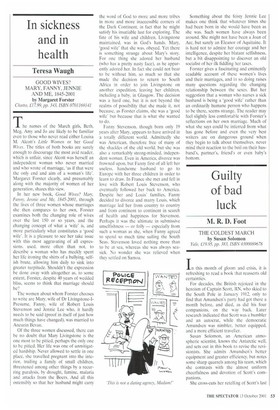In sickness and in health
Teresa Waugh
GOOD WIVES? MARY, FANNY, JENNIE, AND ME, 1845-2001 by Margaret Forster Chatto, £17.99, pp. 343, ISBN 0701169141 The names of the March girls, Beth, Meg. Amy and Jo are likely to be familiar even to those who never read either Louisa M. Alcott's Little Women or her Good Wives. The titles of both books are surely enough to discourage the most avid reader, which is unfair. since Alcott was herself an independent woman who never married and who wrote of marriage, 'as if that were the only end and aim of a woman's life'. Margaret Forster clearly, and presumably along with the majority of women of her generation, shares this view.
In her new book, Good Wives? Marv, Fanny. Jennie and Me, 1845-2001, through the lives of three women whose marriages she then compares to her own, Forster examines both the changing role of wives over the last 150 or so years, and the changing concept of what a 'wife' is, and more particularly what constitutes a 'good wife'. It is a pleasure to see her take issue with this most aggravating of all expressions, used, more often than not, to describe a woman who has meekly spent her life ironing the shirts of a bullying, selfish brute, allowing him daily to sink into greater turpitude. Shouldn't the expression be done away with altogether as, to some extent, Forster, despite 40 years of wedded bliss, seems to think that marriage should be?
The women about whom Forster chooses to write are Mary, wife of Dr Livingstone-IPresume, Fanny, wife of Robert Louis Stevenson and Jennie Lee who, it hardly needs to be said (proof in itself of just how much things have changed), was married to Aneurin Bevan.
Of the three women discussed, there can be no doubt that Mary Livingstone is the one most to be pitied, perhaps the only one to be pitied. Her life was one of unmitigated hardship. Never allowed to settle in one place, she travelled pregnant into the interior, trailing a family of small children, threatened among other things by a recurring paralysis, by drought, famine, malaria and attacks from the Boers. And all this ostensibly so that her husband might carry the word of God to more and more tribes in more and more inaccessible corners of the Dark Continent, in fact that he might satisfy his insatiable lust for exploring. The fate of his wife and children. Livingstone maintained, was in God's hands. Mary, 'good wife' that she was, obeyed. Yet there is something strange about Mary's story. For one thing she adored her husband (who has a pretty nasty face), as he apparently adored her. In fact she could not bear to be without him, so much so that she made the decision to return to South Africa in order to join Livingstone on another expedition, leaving her children, including a baby. in Glasgow. The decision was a hard one, but it is not beyond the realms of possibility that she made it, not because, as Forster claims, she was a 'good wife' but because that is what she wanted to do.
Fanny Stevenson. though born only 19 years after Mary, appears to have arrived in a totally different world. Admittedly she was American, therefore free of many of the shackles of the old world, but she was also a remarkably strong-minded, independent woman. Even in America, divorce was frowned upon. but Fanny first of all left her useless, handsome husband to go to Europe with her three children in order to learn to draw. In France she met and fell in love with Robert Louis Stevenson, who eventually followed her back to America. Despite her and Louis' families, Fanny decided to divorce and marry Louis, which marriage led her from country to country and from continent to continent in search of health and happiness for Stevenson. Perhaps it was the ultimate in submissive unselfishness — or folly — especially from such a woman as she, when Fanny agreed to spend so much time sailing the South Seas. Stevenson loved nothing more than to be at sea, whereas she was always seasick. No wonder she was relieved when they settled on Samoa. Something about the feisty Jennie Lee makes one think that whatever times she had been born in she would have been as she was. Such women have always been around. She might not have been a Joan of Arc, but surely an Eleanor of Aquitaine. It is hard not to admire her courage and her intelligence, despite her blatant selfishness, but a bit disappointing to discover an old socialist of her ilk fiddling her taxes.
Forster gives a fascinating and eminently readable account of these women's lives and their marriages, and in so doing raises many questions regarding the changing relationship between the sexes. But her suggestion that a woman who nurses a sick husband is being a 'good wife' rather than an ordinarily humane person who happens to be there, seems strange. The reader may feel slightly less comfortable with Forster's reflections on her own marriage. Much of what she says could be inferred from what has gone before and even the very best writers are on dangerous ground when they begin to talk about themselves, never mind their reaction to the boil on their husband's, partner's, friend's or even baby's bottom.


























































































 Previous page
Previous page